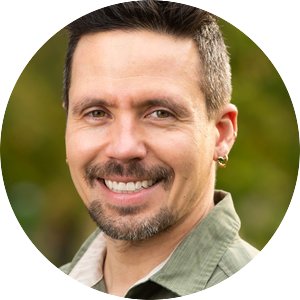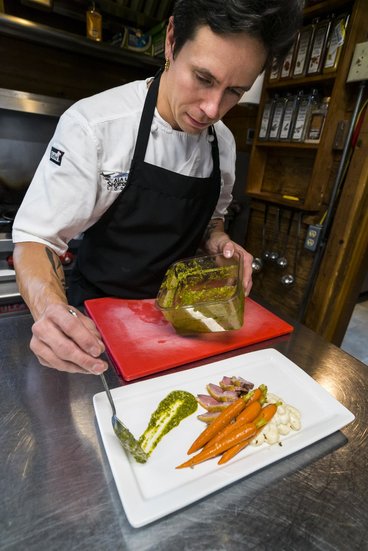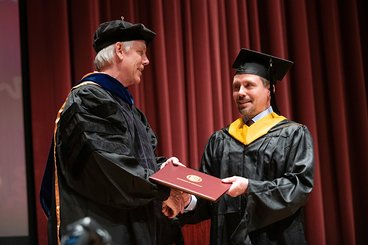
From plate to policy: A student's journey from chef to applied economist

For former chef Alex Chase, the College of Food, Agricultural and Natural Resource Sciences (CFANS) was a natural fit to leverage his experience in the food industry into a new career path focused on food security.
After completing a bachelor’s degree in Agriculture and Food Business Management, Alex Chase debated what step to take next. “I considered going into the food sciences because of my hands-on background as a chef, but I didn’t think that would get me closer to working on the global challenges,” he explains. “Effective policies are what’s needed to make real progress on food security.”
Chase is currently finishing his coursework and thesis for a Master’s of Science in Applied Economics. We sat down with him to talk about his journey to CFANS and how he intends to use research and policy to work on food security issues.
Tell us about your past experience in the food industry. How did you end up at CFANS?
I’ve been working in the food industry for nearly 20 years. When I was an exchange student in Japan, I worked in a friend’s family fish market and then came back to Minnesota and worked as a busboy at a Japanese restaurant through high school. After high school, I attended the Culinary Institute of America in New York and did an internship at a 3-star Michelin restaurant before returning to Minnesota. I worked as a line cook and chef at various James Beard winning restaurants in Minnesota for several years before moving to Alaska to work as executive chef at a high-end fly fishing lodge.

After taking some generals at technical college in between the fishing seasons in Alaska, I transferred into CFANS to get my bachelor's degree in Agriculture and Food Business Management. The program seemed like it was a good fit and it was a strategic pivot from my culinary background into the broader food industry. Reading the book Feeding the Ten Billion by L.T. Evans gave me better insight into how our food system is really working and the headwinds facing it. It made me more passionate about working on food security.
We don’t see many chefs shift into the economics field. Why did you decide to pursue a graduate degree in Applied Economics?
I considered going into the food sciences because of my hands-on background as a chef, but I didn’t think that would get me closer to working on the global challenges and policies necessary to make real progress on food security. I always found research and policy interesting. You see economists on all sorts of programs all the time talking about what research is showing. Understanding economic lingo and conveying it well is its own skill set, and a very powerful tool if used well.
I also really enjoyed the Applied Economics professors and coursework that I was exposed to in my undergraduate program. I took the Grand Challenge Curriculum course World Food Problems: Agronomics, Economics, and Hunger my first semester of undergrad and it was a valuable class focused on food security issues.
Your research is looking at net zero goals in the dairy industry. What are you discovering?
I’m conducting research with Professor Joleen Hadrich that focuses on the economic feasibility for dairy farmers to achieve net zero emissions by 2050. Currently, 74% of all milk processed in the U.S. is under the U.S. Dairy Stewardship Commitment to achieve greenhouse gas neutrality, optimize water usage and improve water quality by 2050. I looked at the large food processors’ sustainability policies and goals to assess where the burden will actually fall for getting to net zero pledges. Most of the burden to meet those goals will be at the farm since three quarters of the emissions in the dairy supply chain are at the field-to-farm-gate and as little as 3% of the emissions come directly from the dairy processor.
I leveraged life cycle analysis tools to generate new estimates for different dairy farm sizes and locations to assess the financial feasibility of various practices that could help achieve the net zero goals. I looked at questions like how much is it going to cost to reduce the greenhouse gas emissions per gallon of milk? How much is a 5% reduction going to cost? And the next 5%? Crop use, land use, how we feed the cows, what we do with the manure, feed mixes, and how energy sources all impact these reductions.
Right now, one of the ways to get closest to achieving the net zero dairy pledges will be for farms to consolidate and get bigger. Economies of scale and other factors can reduce the amount of emissions per gallon of milk, but society isn’t a fan of large farms and having a small number of huge farms supplying all the dairy products to the market wouldn’t create a very resilient system. It’s a tradeoff people need to be aware of.
How are you hoping to use your education and research experience after graduating?

I’d like to get in a position to bring a policy voice to the table of large corporations that may not be as familiar with the food industry even though they may drastically impact it. I’d like to help formulate policy and steer companies to make better choices in regards to sustainability goals that consider long-term negative downstream effects and help maintain profitability at the farm level.
For example, net zero pledges could cause lots of farms to shutter. That might achieve the net zero goals and benefit companies in the short-term, but it wouldn’t be great for society long-term. It’d stretch the food supply chain so thin that there’s no resilience to market shocks. We saw this first hand during the pandemic - if someone in corporate offices was talking about supply chain stretching before the pandemic, no one was listening.





